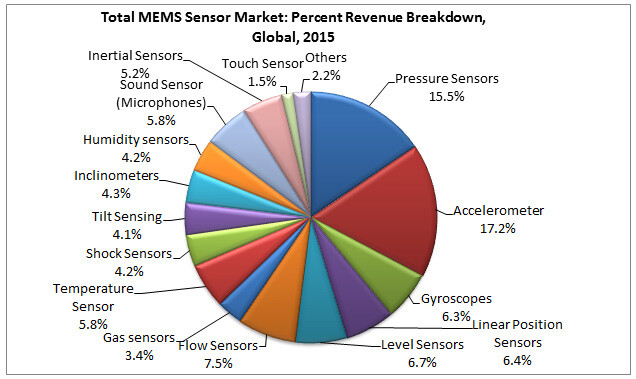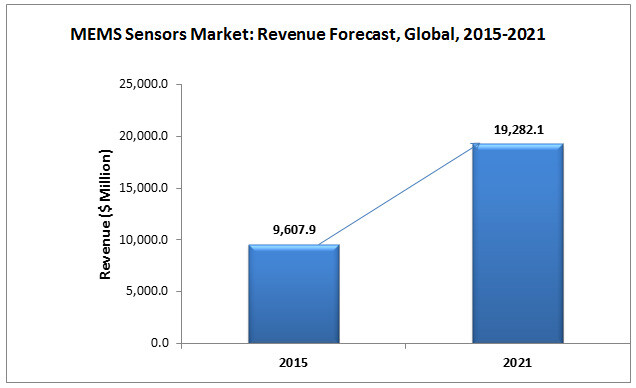Overview
Micro-Electro-Mechanical Systems (MEMS) sensors are in the growth stage of their life cycle, exhibiting growing demand from most of the end users. This trend is likely to continue for many years to come. With ease of miniaturization becoming a reality, numbers of sensors have been developed based on MEMS technology such as pressure, vibration sensors/ accelerometers, inertial forces, gyroscopes, radiation, and temperature. Accelerometers are devices which measure acceleration in one dimension and gyroscopes measure rotational rate. A few of these applications include:
- Motion sensor suite for diverse applications
- Industrial vibration monitoring devices
- Virtual reality gaming devices
- Air bag deployment
- Vehicle stability enhancement systems
- Personal, vehicle, and aircraft navigation systems
With so many possibilities, MEMS are used as a common technology platform for developing different sensors, which have facilitated ease of constructing integrated systems. Most recent trend indicates use of MEMS for monitoring and control applications. MEMS are identified differently by different technologists in different regions. Some refer to those as micromachined sensors /devices while others refer to those as microsystems technology.
Proven Excellence
MEMS sensors have proven high performance as compared to similar sensors based on competing technologies. Using macro level machining to manufacture pressure sensors has resulted in high precision sensors that can be used in critical applications. The accelerometers based on MEMS technology are highly sensitive. They have failsafe performance in extremely critical applications such as airbag activation and vehicle stability within the automotive end user. As is the norm within IC market, manufacturing of MEMS in bulk drives down the cost significantly. Through miniaturization it has been possible to produce nano and micro- sensors for health wellness and preventive health applications. This development has transformed the health monitoring space.
Miniaturization Disproves Performance limitations
MEMS sensor based devices have large variation ranging from being simple structures with having moving elements to extremely complex electromechanical systems having multiple moving elements which are controlled by integrated microelectronics. Miniaturization of MEMS has disproved that performance of a sensor is most often inversely related to its size. Key benefit of miniaturization is substantial improvement frequency response of sensors as their size decreases. However, in terms of limitations some technologists have reported decrease in the raw sensitivity of the MEMS based microphones, pressure sensors, gyroscopes, and accelerometers when miniaturized. At the same time, large investments are being made into research and development of new generation MEMS sensor devices ranging from less than a micron to several millimeters with proven high performance. Increasing demand for the MEMS based sensors is an indication of fast growing penetration of miniature or nano-sensors.
Diverse MEMS Sensor Suite
There is large number of diverse sensor types based on MEMS technology. Currently, there are 15 sensors based on MEMS that are used in diverse application within various vertical end-user markets. They include both stand alone or single parameter monitoring to combined sensors monitoring more than one parameter. Accelerometers and pressure sensors are the largest revenue generators for MEMS sensor market.

The major applications of pressure sensors are in the automotive industry, medical sector, industrial segment, utility, consumer electronics, and oil & gas industry. The demand for pressure sensors is expected to increase in the automotive industry owing to their growing usage in oil pressure monitoring, fuel pressure monitoring, nitrous pressure monitoring, transmission pressure monitoring, and airbag systems and tire pressure monitoring. Applications in automotive and mobile phone manufacturing are the major contributors for the growth of linear sensors.
The increase in the number of applications and functionality in mobile devices and growing awareness in the population about health, fitness, and wellness have led to an increased demand for MEMS accelerometers. Small size, low cost, and low power consumption are driving the usage of MEMS accelerometers in consumer electronics. Smartphones, cameras, and video game controllers use MEMS gyroscopes and are driving the market growth.
Increasing demand for level sensing in industrial manufacturing worldwide is one of the factors driving market. Growing emphasis on energy efficiency, reduced maintenance costs, enhanced asset utilization, and improved process monitoring are favoring adoption of flow sensors in industrial processing plants. With higher level of automation and control solutions, flow sensors and transmitters are poised to witness strong demand. Technology innovation aimed at enhancing the accuracy and reliability of flow meters is estimated to result in higher growth. Technology innovation, primarily due to enhanced manufacturing processes and embedded electronics is expected to boost gas and temperature sensors use. For example, in the automotive sector, hazardous gas emission has led to the framing of legislation for emission control and created the need to monitor vehicle cabin air quality.
The demand for humidity sensors with higher accuracies, higher repeatability, and long-term stability is growing. Wireless humidity sensors are on the rise for monitoring humidity in greenhouses, food industry, mining sector, cement industry, chemical industry, pharmaceutical industry, and automotive industry.
The rising demand for touch-enabled devices such as smartphones and tablets coupled with the rising adoption of touch-enabled e-readers, interactive displays, and digital signage will aid in the growth for touch sensors market. Moreover, the widespread availability of low-cost smartphones in emerging markets, such as China and India, and the increasing number of end users accessing the Internet on smartphones and tablets will bolster the demand for touch-enabled smartphones and tablets during the forecast period. This increase in the demand for smartphones and tablets will, in turn, necessitate the utilization of touch sensors for the production of such devices resulting in market growth.
Market Revenue Growth
In 2015, global MEMS sensors market generated $9,607.9 million ($9.61 billion) which is estimated reach $19,282.1million ($19.28 billion) in 2021. The increase in industrial, consumer electronics, and automotive industries will considerably boost the market.

In automotive industry, motion sensors find integration in security systems, advanced driver assistance systems (ADAS), and airbag deployment systems. Asia-Pacific region is experiencing rapid expansion of automotive industry due to rising domestic demands.
In consumer electronics applications, global Smartphone usage is expected to reach 9.1 billion by 2019 driving the demand for MEMS and NEMS sensors throughout the forecast period. Greater awareness in the health, fitness, and wellness issues is spurring demand for wearable and mobile health technology, in turn fueling the MEMS motion sensor market. Wearable electronics market and fitness monitoring market are expected to provide good revenue growth opportunities.
Product and technological evolution and need for miniaturization are opening up new vistas for revenue growth. MEMS sensors are finding application gaming consoles and sports gears.
However, consumption of billions of sensors by tablets and smartphones coupled with improved production and increased competition has reduced the average selling price of the sensors. High manufacturing, packaging, and testing costs further eat into the already thin profit margins.
Large scale adoption of IOT platform and remote connectivity are likely to result in large number of MEMS based sensors. MEMS being a common technology platform across different sensors enable ease of integration.
Conclusion
The bulk production of MEMS has lead to decline in the average selling price of MEMS which has resulted in high unit shipments across the globe. Growing adoption of smart devices such as smart phones, cameras, media players, and increased purchasing power has led to market growth. Increasing adoption of HVAC modules with the technological advancements and reduced cost price is expected to favorably impact the demand. Strict standards and regulations for safety related mandate electronic devices have also fuelled overall MEMS sensor market growth. With low possession rates and growing disposable incomes, demand for consumer appliances has been growing at a rapid rate among several Asian countries such as India, China, and already higher income NA and European region have indirectly boost the demand for MEMS sensors. The hike in demand for the MEMS-based sensors is an indication of the growing popularity of the miniature sensors and demand for such sensors will increase further over the years to come.



